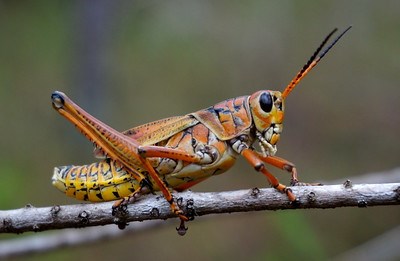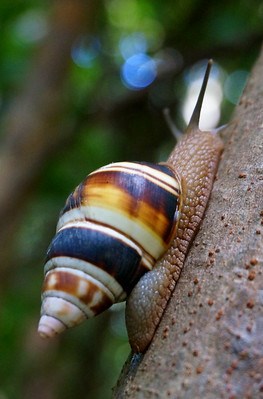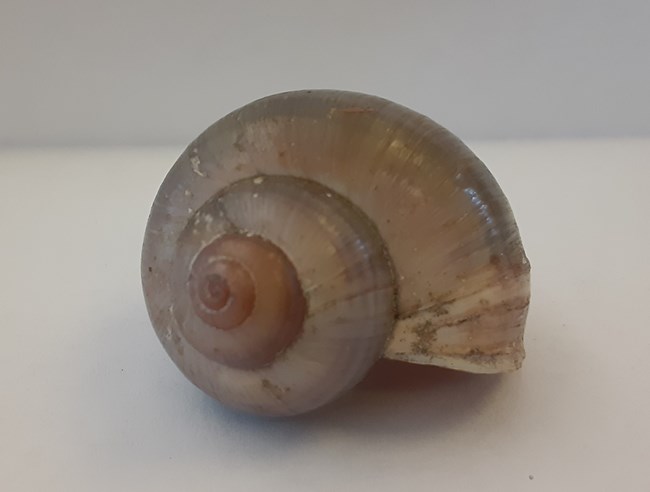|
From quick-moving insects to slimy mollusks, Big Cypress National Preserve is home to a diverse range of invertebrates. While not as conspicuous as many of their animal neighbors, these interesting creatures should not be overlooked!

Appearance: Adult Lubber Grasshoppers in Big Cypress are usually yellow with black and red markings on their wings and body, although their color can vary. Young Lubbers are usually black with a yellow, orange, or red stripe down their back. Size: When they first emerge from their egg, the young grasshoppers are around 0.4 inches in length. As adults, the males are between 1.7-2.2 inches and the females are between 2-2.8 inches. Habitat: Lubbers prefer low, wet areas, but as juveniles they will disperse long distances and can be found in a variety of habitats. Diet: Lubbers eat a wide range of plants, including some types of shrubs, herbs, broadleaf weeds, and grasses. They will also eat non-native plants, including some crops, fruit trees, and ornamental plants. Reproduction: In the summer females use their abdomen to dig a hole in which to lay their eggs. They deposit the eggs in clusters of 30-50 and close the holes with a frothy secretion. The eggs will overwinter in the ground and hatch in the spring, with the young grasshoppers emerging through the frothy plug to find a food source. 
Appearance: The Florida Tree Snail has a cone-shaped shell that can range from white to black in color and is often decorated with a variety of colorful stripes and patterns. Fifty-nine color varieties of this snail have been described over the years. Size: This snail averages around 2 inches in length but may be as long as 3 inches. Lifespan: Florida Tree Snails live an average of 4-5 years. Habitat: Florida Tree Snails are found on tropical and sub-tropical hardwood trees in hardwood hammock habitat. They prefer smooth-barked trees such as wild tamarind (Lysiloma latisiliqua), Jamaica dogwood (Piscidia piscipula), poisonwood (Metopium toxiferum), and pigeon plum (Coccoloba diversifolia). Diet: These snails feed on lichens, algae, and fungi they scrape from tree bark and leaves. Reproduction: Florida tree snails are hermaphrodites, with each individual possessing both male and female reproductive organs. However, mating still occurs between two individuals. Mating occurs in the late summer and early fall rainy season and, 3-4 weeks later, up to 50 eggs are laid in the litter at the base of a tree. At the beginning of the next rainy season the eggs hatch and the young snails, known as buttons, crawl up the tree. 
Appearance: Florida Apple Snails have a round, striped brown shell. Invasive species of Apple Snail can be distinguished from Florida Apple Snails by deep channels between the whorls of the invasive species’ shell. Size: At around 2-3 inches long, Florida Apple Snails are the largest native freshwater snail in North America. Lifespan: This snail lives 1-1.5 years Habitat: Florida Apple Snails prefer shallow, vegetated areas in wetlands, lakes, and rivers. During dry periods, they survive in damp algal mats or mud. Diet: Florida Apple Snails eat periphyton, (an organic mat consisting of blue-green algae, bacteria, fungi, microbes, plant detritus, and animals.) They will also consume other aquatic vegetation. Reproduction: Florida Apple Snails are dioecious, meaning male and female reproductive organs are present in separate individuals. Mating and egg laying occur primarily in the spring. The female lays a clutch of 20-80 pea-sized eggs on a plant stem 6-8 inches above the waterline. The eggs are pink when laid but quickly harden and turn white, hatching after about two weeks. |
Last updated: November 4, 2021
